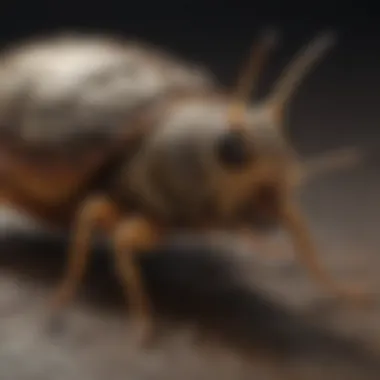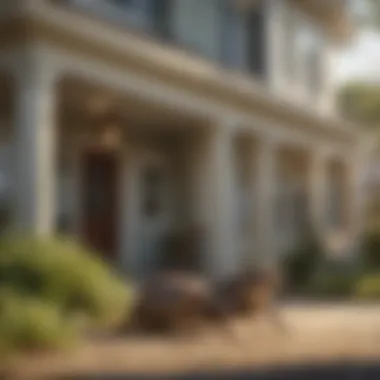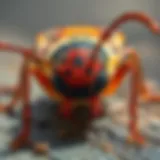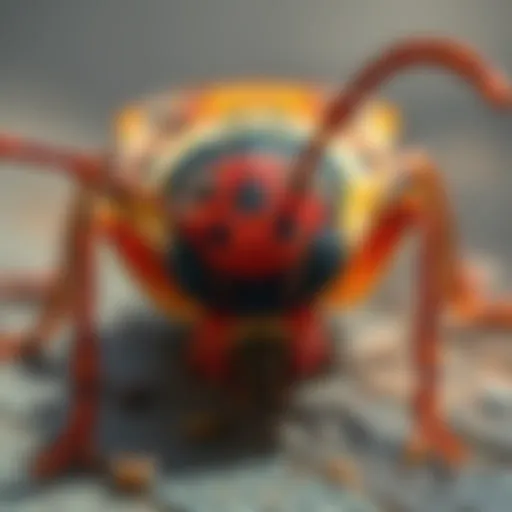Comprehensive Pest Control Guide for Norfolk, VA


Intro
Pest control is a vital aspect of maintaining a comfortable and healthy environment, especially in regions like Norfolk, Virginia. Residents often face various pest issues that stem from the local climate, geography, and urban development. Understanding these challenges is essential for implementing effective management strategies. This guide aims to provide a comprehensive overview of pest control in Norfolk, equipping homeowners and businesses with the knowledge needed to combat pests effectively while considering environmental implications.
Understanding Pests
Pests are organisms that can negatively impact human activities, whether through damaging property, contaminating food, or posing health risks. In Norfolk, various pests are commonly encountered, including ants, rodents, mosquitoes, and termites. Identifying these pests accurately is crucial for effective management. Incorrect identification can lead to wasted resources and inadequate solutions.
Definition of Pests
Pests typically fall into categories such as insects, rodents, and weeds. Each type can pose different threats, which varies depending on the environment. For instance, rodents may invade homes seeking shelter, while certain insects might target gardens and crops.
Importance of Pest Identification
Identifying pests is not just a matter of knowing what is in your home or garden. It also informs the methods used for control and prevention. Understanding the life cycles, habits, and behaviors of specific pests leads to more targeted and effective strategies. Homeowners must take the time to observe and document pest activity to facilitate proper identification.
Prevention Techniques
Preventing pest infestations before they occur is often more effective than dealing with an established problem. Various homeowner strategies can minimize the risk of pests invading your space.
Home and Garden Preventative Measures
- Seal Entry Points: Inspect your home for cracks, gaps, or holes and seal them to prevent pests from entering.
- Proper Food Storage: Store food in airtight containers and ensure that trash bins are covered.
- Maintain Cleanliness: Regular cleaning reduces potential nesting sites and food sources for pests.
- Landscaping: Keep plants trimmed and away from structures to diminish climbing access for insects.
Seasonal Prevention Tips
- Spring: Check for signs of termite activity as the weather warms up. Apply preventive treatments if necessary.
- Summer: Inspect windows and doors for gaps, ensuring screens are intact to avoid mosquito entry.
- Autumn: Clean gutters and downspouts to prevent water accumulation that could attract pests.
- Winter: Store firewood away from the house and inspect for rodent activity as rodents seek warmth.
Eco-Friendly Pest Control Solutions
With increasing awareness of ecological balance, many homeowners are seeking out sustainable practices for pest control. Eco-friendly solutions are not only effective but also minimize harm to beneficial insects and wildlife.
Overview of Sustainable Practices
Sustainable pest management includes the use of biological controls, such as beneficial insects that prey on harmful pests. Integrated Pest Management (IPM) is a strategic approach that combines cultural, mechanical, and biological methods to reduce pest populations sustainably.
Natural Remedies and Their Effectiveness
Natural solutions can be effective for many pest issues:
- Diatomaceous Earth: A natural powder effective against soft-bodied insects, like slugs and cockroaches.
- Essential Oils: Some oils, such as peppermint or tea tree, can repel insects.
Homeowners looking for alternatives to chemical pesticides can consider these remedies. However, it's essential to research the proper application and effectiveness for each specific pest.
Overview of Pest Control in Norfolk, VA
Pest control is a significant concern for residents of Norfolk, Virginia. The city's unique geographical features, including its proximity to water bodies and diverse ecosystems, amplify the variety and prevalence of pests. Understanding how to manage these pests effectively is crucial for maintaining safe and healthy living environments. This section examines key elements that influence pest control practices in Norfolk, from geographic considerations to identifying common pest issues.
Geographic Considerations
Norfolk is located on the southeastern coast of Virginia. This coastal environment contributes to a warm climate that creates ideal conditions for various pests to thrive. The presence of waterways, wetlands, and urban areas plays a crucial role in shaping the types of pest problems residents face.
High humidity levels attract a multitude of insects, including mosquitoes, ants, and termites. The mixed land use, with residential, commercial, and natural areas, leads to unique interactions between humans and pests. Additionally, Norfolk’s varied landscaping can either mitigate or exacerbate pest problems. Homeowners need to consider such factors when implementing pest control solutions.
Successful pest management in this setting requires an understanding of local ecosystems and how urban development influences pest behavior.
Common Pest Issues
Many pest issues are prevalent in Norfolk. Identifying these is vital for effective management. Residents often encounter:
- Mosquitoes: Their populations can flourish in areas with standing water, becoming a nuisance and potential health risk.
- Termites: The humid environment is inviting for termites, which can cause extensive damage to wooden structures.
- Ants: Various species are common, with some being aggressive and others simply a nuisance.
- Rodents: Mice and rats seek shelter in homes, particularly in winter months, leading to contamination and possible destruction of property.
Managing these pests involves understanding their life cycles and behaviors.
Regular inspections and monitoring of pest activity are also essential. Effective pest management does not solely rely on immediate extermination but also on preventive strategies that keep these issues at bay.
"Being aware of common pests and their habits can save homeowners time and money in addressing pest control needs."
In summary, the unique geographic characteristics of Norfolk define the nature of its pest challenges. A proactive and informed approach to pest management will ensure that residents can maintain a pest-free environment.
Types of Pests in Norfolk
Understanding the types of pests common in Norfolk is crucial for effective pest control. Each type of pest presents distinct challenges and requires tailored management approaches. Identifying these pests helps homeowners choose the right strategies and resources. Knowledge of specific pest behaviors informs both immediate action and long-term prevention.
Insects


Insects are a primary concern for homeowners in Norfolk. They can cause property damage, contaminate food, and pose health risks.
Ants
Ants are among the most prevalent insects in the area. Their social nature allows them to invade homes in significant numbers. They can access small cracks, leading to infestations that may seem minor but can grow quickly. Their benefit lies in their role as decomposers, but they also disrupt food storage and cleanliness. The key challenge with ants is locating their nests, as they often build them outdoors, away from human reach. This behavior necessitates persistent management efforts.
Termites
Termites are another key pest in Norfolk. They are notorious for their wood-destroying capabilities. Homeowners need to be vigilant, as these insects can silently compromise the structural integrity of homes. Termites feed primarily on cellulose found in wood, paper, and other plant materials. Early detection is vital, as their damage is often hidden until significant harm has occurred. Effective pest management includes regular inspections and possibly treatments that target their colonies.
Cockroaches
Cockroaches are infamous for their resilience and adaptability. They can thrive in various environments, often entering homes in search of food and shelter. Their presence is unsettling to many, as they can carry diseases and allergens. In addition, cockroaches reproduce rapidly. A small problem can escalate if not controlled quickly. Their ability to survive on minimal food makes them a persistent issue, stressing the importance of thorough sanitation and proper food storage to deter infestations.
Rodents
Rodents, including mice and rats, are a significant concern in urban and suburban areas. They not only damage property but can also pose health risks through disease transmission.
Mice
Mice are small but can create big issues in homes. They reproduce quickly, leading to larger populations if not addressed. Their nesting habits often lead to damage, as they chew through wires, drywall, and food packaging. Mice can enter through tiny openings, making prevention challenging. Effective management includes sealing entry points and managing food sources. Their presence can be indicative of broader pest issues and should not be overlooked.
Rats
Rats are generally larger than mice and are often more aggressive. They can cause extensive damage to buildings and structures due to their size and chewing abilities. Rats also pose serious health risks as they can spread diseases. They tend to be more cautious than mice, making traps less effective at times. Proper sanitation and habitat management assist in deterring rat populations, making it imperative for homeowners to maintain properties.
Wildlife
Wildlife in Norfolk includes various species that can become pests if they invade residential areas. Managing these animals requires understanding their behavior and habitats.
Raccoons
Raccoons are clever and often considered a nuisance. They are known for rummaging through garbage and accessing attics or sheds. Their dexterity allows them to open containers that are not securely closed. Raccoons can also carry diseases, necessitating measures for prevention and control. Effective strategies involve securing trash and closing off entry points to homes.
Squirrels
Squirrels are common in Norfolk and often found in attics or gardens. They can gnaw through roofing materials and wiring, leading to costly repairs. Their activity can also be disruptive, as they make noises that can disturb occupants. While they play a vital role in the ecosystem, their presence in homes requires prompt action. Homeowners should focus on managing their gardens and preventing access to roofs to mitigate problems.
Pest Control Methods
In any discussion about effective pest management, pest control methods are crucial. Choosing the right approach can influence not only the success of the pest control effort but also the impact it has on the environment and human health. This section will delve into the three primary methods of pest control: chemical, biological, and mechanical. Each method offers distinct advantages and considerations for homeowners in Norfolk, VA.
Chemical Control
Chemical control involves the use of pesticides and other chemical agents to manage pest populations. This method can be highly effective for immediate pest eradication, especially in cases of severe infestations. There are various types of chemical solutions available in the market, including insecticides, herbicides, and rodenticides.
However, it is essential to use chemical control judiciously. Overreliance can lead to pesticide resistance, where pests become immune to the chemicals used against them. Additionally, there may be health hazards associated with chemical exposure for both humans and pets. It is wise to research products and follow the label instructions strictly.
Consideration should also be given to local regulations governing pesticide use in Norfolk. Proper disposal of any leftover chemicals is also critical to prevent environmental contamination.
Biological Control
Biological control offers a more environmentally-friendly approach to pest management. This method utilizes natural predators, parasites, or pathogens to control pest populations. For example, ladybugs can be introduced to manage aphid populations, while nematodes may be used to combat soil-borne pests.
The benefit of biological control is its sustainability. Natural methods often lead to long-term pest management solutions with minimal environmental impact. This method encourages biodiversity and promotes a balanced ecosystem. However, the effectiveness can vary based on several factors, such as the specific pests involved and environmental conditions.
Implementing biological control often requires patience, as it may take longer to see results compared to chemical control. Homeowners should consider this when deciding which method to use, especially in urgent situations.
Mechanical Control
Mechanical control encompasses a variety of physical methods to remove, exclude, or repel pests. This can include traps, barriers, and other devices designed to capture or prevent pests from accessing certain areas. For instance, sticky traps can catch flying insects, while rodent traps help deal with mice and rats.
This approach is appealing because it avoids the use of chemicals, thus posing fewer risks to human and animal health. Mechanical control methods can be efficient and often provide immediate results when used properly. Regular inspection of your home for entry points and ongoing maintenance of physical barriers can enhance their effectiveness.
However, mechanical control is often labor-intensive and may require regular monitoring and replacement. Homeowners should be prepared for the ongoing effort to maintain these pest control methods.
The method you choose depends greatly on your unique situation, pest type, and ecological consideration. Each method has its role, and in many cases, a combination of methods yields the best results.
Understanding the strengths and limitations of chemical, biological, and mechanical control is essential for effective pest management in Norfolk, VA. Selecting an appropriate method for the specific pest problem can lead to more sustainable pest management solutions.
Integrated Pest Management (IPM)
Integrated Pest Management (IPM) is a vital approach in the field of pest control that combines multiple strategies to minimize pests in a way that is effective and environmentally responsible. This method takes into consideration not just the pests themselves but also the ecosystem in which they exist. In Norfolk, VA, where the local climate and ecology can support various pest species, IPM becomes particularly important. It is an adaptive management system designed to address the specific needs of homeowners while preventing pest populations from becoming a nuisance.
IPM emphasizes understanding the biology and behavior of pests, which allows for targeted responses that do not rely solely on chemical treatments. By focusing on long-term prevention and pest management, this approach helps maintain a balance between human activity and natural ecosystems. Many homeowners in the Norfolk area can benefit from the principles and practices of IPM, leading to healthier living environments and reduced reliance on potentially harmful pesticides.


Principles of IPM
The principles of IPM revolve around proactive strategies aimed at prevention and control of pest populations. These principles include:
- Monitoring: Regular observation of pest activity helps to determine if control measures are necessary. This includes visual inspections, trapping, and using pheromone lures.
- Identification: Accurate identification of pests is crucial. It enables tailored approaches to managing specific pests while avoiding unnecessary treatments for benign insects.
- Thresholds: Setting action thresholds for when intervention is needed. This prevents unnecessary or premature use of control measures.
- Control Methods: This involves a combination of biological control, physical methods, cultural practices, and chemical measures used only when absolutely necessary.
- Evaluation: After implementing a control strategy, evaluating its effectiveness provides insights into future pest management plans.
Each of these principles plays a critical role in reducing pest populations while minimizing harm to beneficial organisms in the environment.
Benefits of IPM
Utilizing Integrated Pest Management provides several benefits that align with responsible pest control efforts:
- Environmental Protection: Reducing the quantity of pesticides used helps to protect local wildlife and preserve the surrounding ecosystem.
- Cost-Effectiveness: By preventing pest problems before they escalate, IPM can reduce overall pest control costs in the long run.
- Sustainability: This approach encourages sustainable practices that benefit the community and environment alike, focusing on long-term solutions rather than short-term fixes.
- Health Safety: Minimizing chemical exposure reduces risks to human health, especially important for families with children or pets.
- Biodiversity Support: By fostering a healthy habitat, IPM supports a greater diversity of beneficial insects and plants, contributing to ecological balance.
Eco-Friendly Pest Control Solutions
The growing awareness surrounding environmental issues has made eco-friendly pest control solutions increasingly relevant. These methods aim to manage pest populations while minimizing harm to the surrounding ecosystems. They cater to individuals who prioritize sustainability in their daily lives, including homeowners in Norfolk. Embracing eco-friendly practices not only assists in effective pest control but also contributes to a healthier living environment.
Organic Pest Control Products
Organic pest control products are formulated from natural substances that are less impactful on human health and the environment. Examples include neem oil, diatomaceous earth, and insecticidal soaps. Utilizing organic products has multiple advantages, including:
- Reduced Toxicity: Organic products are typically less toxic to humans, pets, and beneficial insects like bees and butterflies.
- Sustainability: Many organic options are derived from renewable resources, promoting ecological balance.
- Soil Health: Organic solutions can improve soil health by avoiding harmful chemical residues that synthetic pesticides may leave over time.
For homeowners in Norfolk, choosing organic options can be a wise decision. When selecting these products, it's essential to read labels carefully and adhere to application instructions to ensure effectiveness while maintaining safety.
Natural Predators
Another critical component of eco-friendly pest control is the use of natural predators. Various species, such as ladybugs, lacewings, and birds, play an essential role in controlling pest populations. By introducing or encouraging these predators in your garden, you can establish a natural balance. The key benefits include:
- Biological Control: Natural predators eliminate pests without the need for chemical interventions.
- Sustainable Farming Practices: This approach supports integrated pest management strategies, promoting biodiversity in the ecosystem.
- Long-Term Results: Over time, natural predation can reduce the pest population, leading to less frequent infestations.
Maintaining a diverse garden that attracts beneficial insects can significantly aid in pest management on your property. Homeowners can plant native flowers and avoid broad-spectrum pesticides to create a conducive environment for these natural allies.
"Eco-friendly pest control solutions not only protect your home but also the planet, fostering a healthier ecosystem for future generations."
Understanding eco-friendly pest control solutions is vital for implementing effective strategies in residential settings. By utilizing organic products and promoting natural predation, residents in Norfolk can manage pest issues responsibly while contributing to the sustainability of their environment.
Preventative Measures
Preventative measures are crucial in managing pest populations effectively. Taking a proactive stance not only reduces the likelihood of infestations but also minimizes the need for more invasive control methods. This section delves into the specific elements that contribute to effective pest prevention. It emphasizes the benefits of early intervention and ongoing maintenance efforts that help keep pest issues at bay.
Home Inspection
Regular home inspections play a vital role in pest control. Homeowners should be vigilant about checking their properties for potential pest entry points or signs of infestation. Inspections should include a thorough examination of common problem areas, such as:
- Basements and Crawl Spaces: These areas are prone to moisture, attracting pests like termites and rodents. Look for signs of dampness or wood damage.
- Attics and Roofs: Inspect for gaps, missing shingles, or holes that pests could use to enter your home. Birds and squirrels often find their way in through these openings.
- Around Windows and Doors: Ensure that seals are intact, and screens are repaired to prevent insects from entering.
- Landscaping Perimeters: Keep an eye on vegetation that may provide cover for pests.
By conducting thorough inspections, homeowners can identify issues early, allowing for prompt intervention before they escalate. Regular upkeep can save you from expensive pest control treatments later on, ensuring your living environment remains comfortable and pest-free.
Landscape Management
Effective landscape management is another integral aspect of preventing pest issues. The outdoor environment can significantly influence pest populations inside your home. Here are some important factors to consider for better landscape upkeep:
- Maintain Proper Drainage: Standing water invites mosquitoes and other pests. Ensure your landscape has adequate drainage to prevent pooling.
- Regularly Trim Trees and Shrubs: Dense foliage can create a perfect habitat for pests. Keep plants trimmed and remove debris to eliminate hiding spots.
- Mulch Carefully: While mulch can help with soil moisture, it can also attract termites. Use it sparingly and keep it at least 6 inches away from the foundation.
- Select Pest-Resistant Plants: Choose native or pest-resistant flora that require less chemical intervention, reducing the chemical footprint in your garden.
By establishing a proactive landscape management strategy, homeowners can significantly reduce the risk of pest infestations. Making smart choices with landscaping not only enhances the beauty of a property but creates an environment that discourages pest activity.
"Prevention is better than cure." It is wiser to take steps to prevent pest issues than to deal with them after they arise."
Implementing these preventative measures can create a healthier living space, diminish the chances of pest invasions, and lead to a more enjoyable home environment.
Local Regulations and Compliance
Understanding local regulations related to pest control is crucial for effective management and compliance. These laws not only protect property and health but also contribute to environmental stewardship. Adhering to regulations helps homeowners and pest control businesses practice responsible methods while minimizing harmful impacts on local ecosystems. This section will focus on two major aspects of local regulations in Virginia: pest control licensing and chemical usage regulations.
Pest Control Licensing in Virginia
In Virginia, pest control services must be licensed to ensure safety and compliance with state laws. This licensing process is designed to guarantee that pest control professionals possess the necessary knowledge, training, and skills to manage pest issues effectively. Licensed pest control operators must display their credentials and are often required to engage in continuing education. Understanding these requirements can help homeowners select reputable service providers who adhere to industry standards.
The licensing process in Virginia includes:
- Examinations: Operators must pass exams that assess their knowledge of pest biology, control methods, and safety practices.
- Background Check: A review of the applicant’s history helps ensure reliability and integrity in the field.
- Continuing Education: Regular training updates operators on the latest methods and regulations.
Homeowners should verify proper licensure before hiring any pest control service. This ensures they are working with qualified professionals, mitigating risks of improper pest management that could harm both property and health.


Chemical Usage Regulations
Chemical usage regulations in Virginia serve to protect both human health and the environment. These laws dictate how pesticides can be applied, the types that can be used, and the necessary precautionary measures to be followed. Understanding these regulations is vital for homeowners and landlords, as improper use of chemicals can lead to contamination of soil and water, as well as health risks for residents and pets.
Key elements of chemical usage regulations include:
- Labeling and Safety Data Sheets: All pesticides must be clearly labeled and come with safety information that outlines proper handling and application procedures.
- Restricted Use Products: Certain chemicals may only be applied by licensed professionals due to their potential risk. Homeowners should be aware of these restrictions.
- Application Timing: Regulations often dictate when and how pesticides can be applied to minimize environmental impact, such as avoiding application during wet weather to prevent runoff.
Complying with chemical usage regulations fosters a healthier living environment and encourages sustainable pest management practices. Ignoring these rules can lead to significant penalties and negative consequences for the ecosystem.
Staying informed about local regulations regarding pest control is not only a legal responsibility but also a commitment to safeguarding your home and community.
Resources for Pest Management
Managing pest control effectively requires a variety of resources tailored specifically to the needs of homeowners and residents in Norfolk, VA. Utilizing local resources can enhance the overall management process, ensuring that strategies are both efficient and compliant with regulations. In this section, we will explore two key areas: Professional Pest Control Services and Government Agencies and Support. These resources can serve as essential allies in the fight against pest issues.
Professional Pest Control Services
When dealing with persistent or widespread pest problems, engaging professional pest control services can be a practical choice. These companies offer expertise and equipment that may not be available to the average homeowner. Their services often include detailed inspections, customized treatment plans, and ongoing maintenance to prevent future infestations.
Some of the benefits of hiring professional services include:
- Expert Knowledge: Professionals are trained in identifying pest species and understanding their behaviors. This insight helps in applying the most effective control methods.
- Access to Advanced Tools: Many pest control services utilize advanced technology and methods that are more effective than over-the-counter solutions.
- Time Efficiency: Pest control can be time-consuming. Professionals can often resolve an issue quicker than an individual could on their own, allowing homeowners to focus on other priorities.
- Safety Considerations: Professionals are knowledgeable in handling chemicals and techniques safely, protecting both residents and the environment.
In Norfolk, local companies such as Terminix and Orkin provide specialized pest control services designed for the region’s unique challenges. They often have insight into local pest behaviors, contributing to more effective management solutions.
Government Agencies and Support
Various government agencies exist to support residents dealing with pest issues in Norfolk. These entities provide important resources, including information on local regulations, pest identification guides, and support during pest outbreaks. Their role is critical, as they often serve as a bridge between the community and best practices in pest management.
Key agencies include:
- Virginia Department of Agriculture and Consumer Services: This agency oversees pest management regulations and offers resources for effective pest control practices. They also promote education on the ecological impacts of certain pest control methods.
- Local Health Departments: In Norfolk, the health department addresses public health concerns related to pests, such as rodents and mosquitoes. They often run educational programs that inform the community about prevention and control strategies.
- University Extension Services: Many universities offer extension services that provide research-based information and resources for managing local pest problems. They can help homeowners understand pest behaviors and the best methods to control them.
"Engaging with local authorities not only enhances your pest management strategy but also ensures you comply with all necessary regulations."
By leveraging these resources effectively, homeowners can approach pest control in a more informed and structured way. This ensures a comprehensive management plan that aligns with both personal and community needs.
Case Studies of Pest Control in Norfolk
Case studies play a crucial role in understanding pest control effectiveness in Norfolk, VA. They provide concrete examples of how specific strategies have been implemented to address local pest problems. This section examines real-world applications of pest management, identifying practices that have led to both successes and failures. By analyzing these cases, readers can grasp practical lessons which help shape their approaches to pest control within their own homes or businesses.
Successful Pest Management Strategies
Successful pest management often stems from a mix of strategic planning and timely execution. Here, we analyze various case studies showcasing effective techniques that were tailored for unique pest challenges encountered in Norfolk.
One notable success was the approach taken by a local garden center to combat an infestation of aphids and other plant pests. They implemented an Integrated Pest Management (IPM) strategy that involved monitoring pest populations and using organic pesticides as a last resort. The center also encouraged the use of natural predators such as ladybugs, which effectively reduced aphid numbers without harming other beneficial insects. This case highlighted how incorporating biological control can lead to sustainable pest management outcomes.
Another effective strategy was developed by a homeowner who dealt with a rat infestation. After thorough inspection, the homeowner identified gaps in the foundation that allowed rodents to enter. By sealing these entry points and adopting better food storage practices, they drastically reduced the rodent population. This study illustrates the importance of preventative measures in pest control.
Lessons Learned
From the case studies reviewed, several key lessons emerge regarding pest control in Norfolk. Firstly, periodic inspections and maintenance are essential. Homeowners and businesses must take a proactive approach to identify vulnerabilities before they escalate into larger problems. Overlooking minor issues can often lead to significant infestations.
Secondly, education plays an important role. Engaging local pest control professionals or utilizing community resources often leads to better pest management. For example, community workshops raise awareness about pest identification and prevention techniques. These gatherings foster collaboration and sharing of experiences, resulting in more informed decisions regarding pest management.
Lastly, flexibility is vital. What works for one situation may not be effective for another. Pest species vary, as do the environments in which they thrive. Adapting strategies based on emerging data from ongoing case studies is crucial for success. By learning from varied experiences and adjusting techniques accordingly, better outcomes can be secured.
"The efforts we place in preventing pest issues can prevent future headaches and costs. It is an investment worth making."
Future Trends in Pest Control
Pest control is an ever-evolving field. This section aims to explore emerging trends that are shaping how we manage pests in Norfolk, VA. Understanding future trends is crucial, as the methods and technologies we adopt can significantly impact efficacy and environmental health. It is essential to grasp these advancements to make informed decisions for effective pest management.
Technological Advancements
Recent years have seen a rapid integration of technology into pest control strategies. Innovations such as smart pest monitoring systems are becoming more prevalent. These systems use sensors and artificial intelligence to detect pest activity in real time. Homeowners can receive alerts through their smartphones, streamlining the response to potential infestations.
Another notable advancement is the use of drones. Drones equipped with specialized cameras can survey large areas, identifying hotspots of pest activity without the need for extensive ground inspections. This efficiency not only saves time but also reduces the need for chemical treatments by concentrating efforts on specific areas.
Moreover, biopesticides have gained traction. These natural substances are derived from living organisms and can target specific pests without harming beneficial insects. The use of biopesticides aligns with a growing interest in sustainable practices, offering an eco-friendly alternative to traditional chemical pesticides.
"Technology is not just a tool. It is a strategic partner in pest management."
Sustainable Practices
Sustainable practices are increasingly gaining attention in pest control. The focus is shifting from reactive treatments to preventative measures. Integrated Pest Management (IPM) emphasizes the need to understand pest life cycles and their interaction with the environment. By employing techniques such as habitat manipulation and crop rotation, it becomes possible to create conditions less favorable for pests.
Additionally, the reduction of chemical usage is a significant trend. Homeowners are more aware of the potential health hazards associated with harsh chemicals. Natural remedies, such as neem oil or diatomaceous earth, are being favored for their effectiveness and reduced environmental impact. These alternatives can deter pests while being less toxic to humans and pets.
Furthermore, community awareness and education play a vital role. Workshops and online resources are helping residents educate themselves on sustainable choices. Engaging with local experts and sharing knowledge enhances a community's ability to tackle pest issues collectively. Building these practices into local pest control strategies reflects a commitment to long-term ecological balance.



